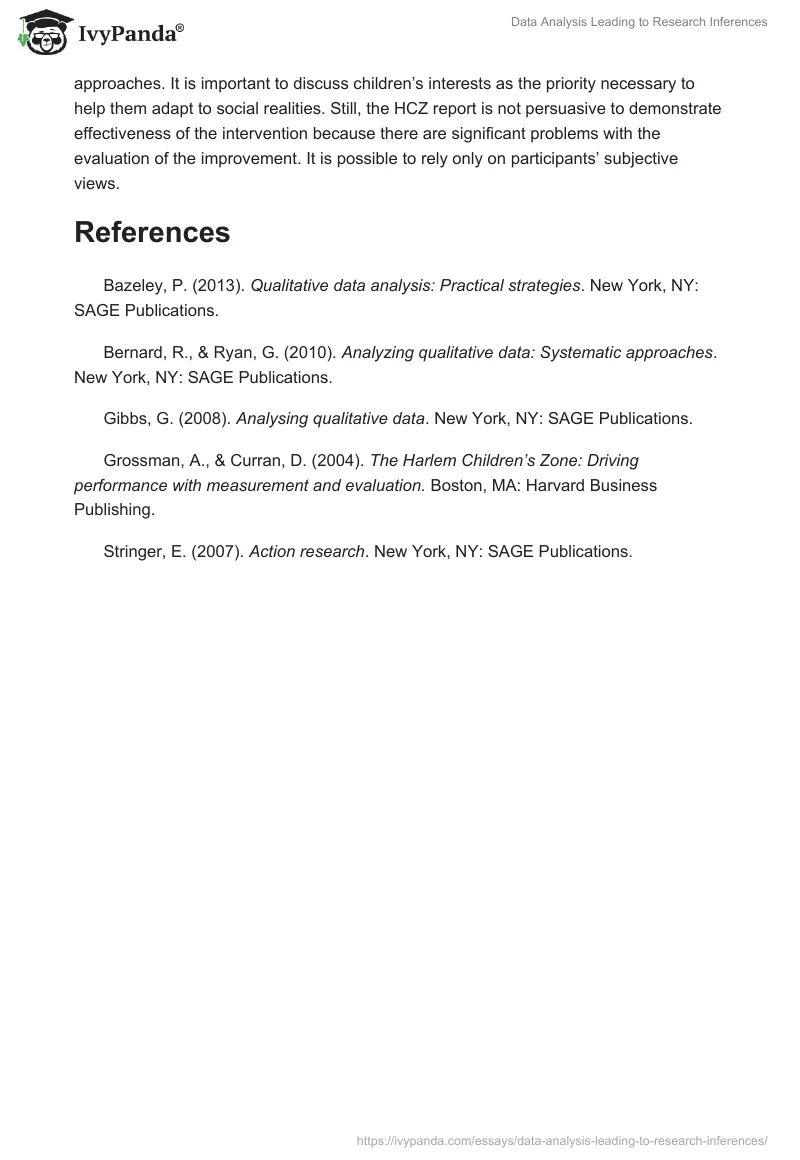Part One
Five block quotes were selected from the Harlem Children’s Zone Case Study (Grossman & Curran, 2004, p. 12). Quotes discussing the effectiveness of the HCZ intervention and associated improvement were chosen for coding and for the further analysis. The thematic coding of the quotes was conducted in several steps (Bazeley, 2013, p. 24). During the first stage, the quotes were reviewed and organized according to the author of the words (Bernard & Ryan, 2010, p. 24). The second step was the process of identifying the units of meaning in the quotes (Stringer, 2007, p. 99). Actual meaningful words of the authors were marked and put in the column “Details”. The next step was the process of putting the authors’ actual words under categories (Gibbs, 2008, p. 112). The final step was the identification of themes. Three themes were identified as basic ones in order to discuss the intervention’s direction and effectiveness (Appendix 1).
Part Two
After coding the qualitative data associated with the HCZ case study, it is possible to identify such themes: ‘Children’s social adaptation’, ‘Children’s orientation’, and ‘Adherence to the project’s goals and mission’. Following the theme ‘Children’s social adaptation’, the participants of the project focus on the important role of developing children’s academic and social skills for their further life. Additionally, concentrating on ‘Children’s orientation’, the authors note that to assist children to find their paths in life, it is necessary to focus on children’s interests as the priority and provide opportunities to learn the variety of skills. Furthermore, to promote improvement, it is necessary to adhere to the project’s specific goals and mission.
Therefore, the retrieved qualitative data supports the idea that the intervention caused improvement with references to addressing children’s interests in areas associated with the HCZ project. The intervention’s success lies in using right goals and approaches. It is important to discuss children’s interests as the priority necessary to help them adapt to social realities. Still, the HCZ report is not persuasive to demonstrate effectiveness of the intervention because there are significant problems with the evaluation of the improvement. It is possible to rely only on participants’ subjective views.
References
Bazeley, P. (2013). Qualitative data analysis: Practical strategies. New York, NY: SAGE Publications.
Bernard, R., & Ryan, G. (2010). Analyzing qualitative data: Systematic approaches. New York, NY: SAGE Publications.
Gibbs, G. (2008). Analysing qualitative data. New York, NY: SAGE Publications.
Grossman, A., & Curran, D. (2004). The Harlem Children’s Zone: Driving performance with measurement and evaluation. Boston, MA: Harvard Business Publishing.
Stringer, E. (2007). Action research. New York, NY: SAGE Publications.


